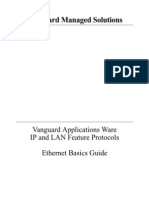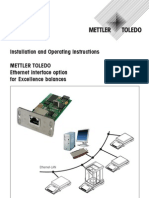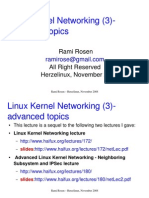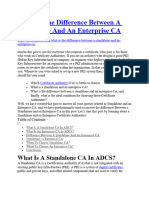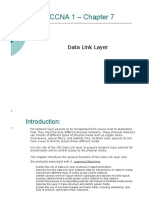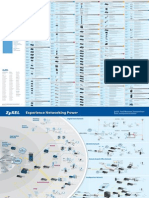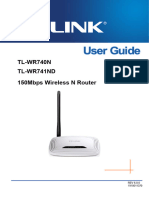Configuration For Devices 42
Configuration For Devices 42
Uploaded by
Anonymous OYLvnCxCopyright:
Available Formats
Configuration For Devices 42
Configuration For Devices 42
Uploaded by
Anonymous OYLvnCxOriginal Description:
Original Title
Copyright
Available Formats
Share this document
Did you find this document useful?
Is this content inappropriate?
Copyright:
Available Formats
Configuration For Devices 42
Configuration For Devices 42
Uploaded by
Anonymous OYLvnCxCopyright:
Available Formats
The Honeywell Control Firewall must be added to the Network Tree within
Configuration Studio.
If you can communicate with the Honeywell control firewall from the local node, the
Control Firewall Update Tool appears as a task from the control firewall device.
9.10.5 Launch the control firewall update tool
To launch the tool from Configuration Studio
1. Expand the network tree and click on devices.
2. From the right pane, select Launch control firewall update tool.
3. For more information, see the online help accessed from the tool.
To launch the tool from the Start menu
1. From your computer's Start menu, select All Programs > Honeywell Experion PKS
> Engineering Tools > Control Firewall Update.
2. For more information, see the online help accessed from the tool.
9 INSTALLING AND REPLACING SWITCHES
131
9 INSTALLING AND REPLACING SWITCHES
132 www.honeywell.com
10 Troubleshooting Network Issues
Related topics
“Preventing Crosslink Errors” on page 134
“Intermittent or blocked communication to controllers on a different subnet” on
page 136
“Mismatch of FTE multicast address and destination port” on page 137
133
10.1 Preventing Crosslink Errors
Related topics
“FTE diagnostic messages” on page 134
“Definition of crosslink error” on page 134
“Potential causes of crosslink errors” on page 134
10.1.1 FTE diagnostic messages
FTE sends diagnostic messages on each of the FTE interface ports. One part of the
diagnostic message designates the interface port for the message. That is, whether the
message is transmitted on the Yellow tree or on the Green tree. FTE uses the MAC
address to define which interface is Yellow and which interface is Green. The interface
port connection that has lower MAC address is defined as Yellow and the interface port
connection that has higher MAC address is defined as Green. This binding order must
remain consistent to maintain the correct interface port designation for the messages.
10.1.2 Definition of crosslink error
Both types of diagnostic messages (yellow and green) are transmitted on both FTE trees
when the network has a switch crossover cable connected. However, when the trees are
isolated from one another, the diagnostic messages must also be isolated. Only messages
designated as Yellow must be seen on the Yellow tree and only messages designated as
Green must be seen on the Green tree. A crosslink error occurs when, even after the
crossover cable is removed and the trees are isolated, Yellow diagnostic messages are
seen on the Green tree or green diagnostic messages are seen on the Yellow tree.
10.1.3 Potential causes of crosslink errors
The following table lists some of the causes for crosslink errors and gives examples how
they occur.
10 TROUBLESHOOTING NETWORK ISSUES
134 www.honeywell.com
Cause Examples
Cables are crossed at the
node or at the switches
• Cable with the Yellow boot is connected to the switch in the
Yellow tree, but it is connected to the second port.
• Cable with the Green boot is connected to the switch in the
Green tree, but it is connected to first port.
• Connection for first port (cable with Yellow boot) is connected
to the switch in the Green tree.
• Connection for second port (cable with the Green boot) is
connected to the switch in the Yellow tree.
Both FTE cables are
connected to the same tree
Cable with the Yellow boot and cable with the Green boot are
connected to the same switch.
Binding order is “reversed” • Cable with the Yellow boot is connected to the first port and to
the Switch in the Yellow Tree, but the connection for the first
port has higher MAC address.
• Cable with the Green boot is connected to the second port and
to the Switch in the Green tree, but the connection for the
second port has lower MAC.address
FTE network topology does
not follow configuration
rules
Any condition that creates network path loops, such as any of the
following:
• FTE network has more than one crossover cable
• Multiple connections to an external network
• Switches are not in a tree hierarchy
Several servers have
multiple (4) NIC
connections
Verify which cables are inserted
10 TROUBLESHOOTING NETWORK ISSUES
135
10.2 Intermittent or blocked communication to
controllers
on a different subnet
When Controllers are addressed in a different subnet than the server/console, the level 2
nodes rely on addroute and ARP to establish TCP connections with controllers. If proxy
ARP is enabled on the router, the router responds with its own MAC address when the
level 2 nodes ARP for the controller MAC addresses, preventing or breaking TCP
communication. Hence, all router connections to an FTE network must have the no ip
proxy arp command.
10 TROUBLESHOOTING NETWORK ISSUES
136 www.honeywell.com
10.3 Mismatch of FTE multicast address and
destination
port
An FTE node does not show up in the FTE node list or FTE status display as expected.
10 TROUBLESHOOTING NETWORK ISSUES
137
10 TROUBLESHOOTING NETWORK ISSUES
138 www.honeywell.com
11 Switch and Router Configuration
Examples
Related topics
“Cisco switch and router examples” on page 140
“Cisco router configuration statements” on page 141
“Subnet mask derivation” on page 144
“Stacked switch configuration examples” on page 145
139
11.1 Cisco switch and router examples
Cisco 2960 Configuration Example
The following configuration file is an example of 4u_410_2960_24.text which will
configure.
• 4 uplinks (downlinks)
• 4 FTEB ports configured
• 40 100 Megabit or GBIC ports
11 SWITCH AND ROUTER CONFIGURATION EXAMPLES
140 www.honeywell.com
11.2 Cisco router configuration statements
To configure the FTE community filtering requirements in Cisco routers, specific
configuration commands are used, examples of which are provided in this section.
Related topics
“Access control lists” on page 141
“Cisco 3560, 2960, IE3000 access list for protecting Safety Manager or third-party
safety controllers” on page 142
11.2.1 Access control lists
Cisco uses an Access Control List (ACL) to describe what must pass and what must not
pass through an interface. Following is an example of a set of ACLs used to provide the
filtering.
access-list 101 permit tcp 10.0.0.0 0.0.0.255 any established
Established connections are allowed in the whole FTE community subnet
The range of addresses in this FTE community is 10.0.0.2-255
access-list 101 permit udp host 225.7.4.103 any
access-list 101 permit udp any host 225.7.4.103
The DSA multicast address, 225,7.4.103 is allowed to pass in both directions
access-list 101 permit ip 10.0.0.0 0.0.0.240 any
access-list 101 permit ip any 10.0.0.0 0.0.0.240
The server range is 10.0.0.2-15
access-list 101 permit udp any any eq domain
Access to a domain controller TCP port is allowed.
access-list 101 permit udp any any eq 88
Access to a Kerberos server is allowed
access-list 101 permit udp any any eq 389
Access to a LDAP server is allowed
There is an assumed “deny all” at the end of the list. This means that any other address
range is denied access.
These access lists are attached to the VLAN the FTE community is connected with as
shown in the following example:
11 SWITCH AND ROUTER CONFIGURATION EXAMPLES
141
interface Vlan101 ip address 10.0.0.1 255.255.255.0
VLAN 101 is the FTE community VLAN. The FTE default gateway address is 10.0.0.1. The
subnet mask of 255.255.255.0 will allow traffic in this range to pass to the ACL filters
ip access-group 101 out
Access-group 101 uses the ACLs described above in access-list 101
no ip proxy-arp
Proxy arp must be disallowed to enable hiding the L1 addresses from L3
ip pim dense-mode
PIM dense-mode is needed for the DSA multicasts to be routed.
The following is an example router interface configuration for the interface where the FTE
community is connected.
interface FastEthernet2/3
This example has a connection to a 4006 interface in slot 2, third fast Ethernet port.
switchport access vlan 101
switchport mode access
The switchport (this interface) is set to be access to a VLAN and the VLAN is set to 101.
The above ACLs were attached to VLAN 101
duplex full
speed 100
The speed and duplex if the interface is fixed to avoid problems with autosensing.
11.2.2 Cisco 3560, 2960, IE3000 access list for protecting Safety Manager or
thirdparty
safety controllers
A level of protection is required for embedded nodes such as Safety Manager by limiting
the nodes allowed onto the Safety Ethernet network to the servers that access the nodes.
In this example, the servers have addresses 10.1.4.10 and 10.1.4.11. The protection
consists of an access list to define the allowed addresses and an access group attached to
the crosslink interface of the split switch on the L1 half. The configuration file contains
the following:
• Access-list 130 permit ip 10.1.4.10 0.0.0.0 any
• Access-list 130 permit ip 10.1.4.11 0.0.0.0 any
• The standard configuration for the split switch file can be modified to substitute the
above for the access-list 130 in the file before downloading to the switch
11 SWITCH AND ROUTER CONFIGURATION EXAMPLES
142 www.honeywell.com
• Hence, for a split switch the L1 uplink interface is Fast Ethernet 0/13 so the
configuration file contains the following:
– interface FastEthernet0/13
– switchport access vlan 1
– switchport mode access
– no ip address
– duplex full
– speed 100
– ip access-group 130 in
The multicast and broadcast storm control on this interface are not needed due to the
strict filtering, only allowing server traffic through.
11 SWITCH AND ROUTER CONFIGURATION EXAMPLES
143
11.3 Subnet mask derivation
For connected networks, three subnet masks must be derived from the number of
supported nodes. Some number of least significant bits of the netmask must be set to
zero to cover the number of nodes on the subnet (from each node’s point of view).
L2-L3 router port netmask example
• Two server FTE nodes = 4 IP Addresses
• Gateway (router port) = 1 IP Address
• 4 + 1 rounded up to power of 2 = 8, or 0xFFFFFFF8 (255.255.255.248)
L2 node netmask example
• Sixteen non-server FTE nodes = 32 IP Addresses
• 4 + 1 + 32 rounded up to power of 2 = 64 or 0xFFFFFFC0 (255.255.255.192)
Route add mask example
• Number of embedded FTE nodes * 2 rounded up to power of 2
• Max FTE nodes is 511 = 1024 or 0xFFFFFC00 (255.255.252.0)
• L1 Node Netmask
• Must ignore all unique L2 and L1 address bits = 0xFF000000 = 255.0.0.0
11 SWITCH AND ROUTER CONFIGURATION EXAMPLES
144 www.honeywell.com
11.4 Stacked switch configuration examples
Related topics
“Single domain controller with a 100 mb or CF9 connection” on page 145
“Uplink to 100 mb switch connection on switch 1, port 12” on page 145
11.4.1 Single domain controller with a 100 mb or CF9 connection
Following is an example of a stacked switch configure file that configures the second
switch in the stack with a 100 mb connection on port 12 to be used for a CF9 or single
domain controller connection.
interface GigabitEthernet2/0/12
switchport access vlan 101
switchport mode access
service-policy input cda_policy
You might also like
- BGP Route Selection: Huawei Technologies Co., Ltd. All Rights ReservedNo ratings yetBGP Route Selection: Huawei Technologies Co., Ltd. All Rights Reserved25 pages
- Introduction To Networks Version 70 ITNv7 Practice Final Exam AnswersNo ratings yetIntroduction To Networks Version 70 ITNv7 Practice Final Exam Answers27 pages
- What Functionality Do Access Control Lists Provide in The Implementation of DynamicNo ratings yetWhat Functionality Do Access Control Lists Provide in The Implementation of Dynamic29 pages
- Probing: Beaconing Association AuthenticationNo ratings yetProbing: Beaconing Association Authentication18 pages
- CCNA4 Final G (Sep 2009) : I Will Post Img LetterNo ratings yetCCNA4 Final G (Sep 2009) : I Will Post Img Letter13 pages
- Vanguard Managed Solutions: Vanguard Applications Ware IP and LAN Feature Protocols Ethernet Basics GuideNo ratings yetVanguard Managed Solutions: Vanguard Applications Ware IP and LAN Feature Protocols Ethernet Basics Guide18 pages
- Part-1: 1. A Wireless Client Is Attempting To Establish A Connection With A Wireless Access Point. What ProcessNo ratings yetPart-1: 1. A Wireless Client Is Attempting To Establish A Connection With A Wireless Access Point. What Process81 pages
- 5.3 Level 2 To Level 3 Best Practices: 5.2.2 Using Redirection Manager (RDM) With Level 3No ratings yet5.3 Level 2 To Level 3 Best Practices: 5.2.2 Using Redirection Manager (RDM) With Level 33 pages
- 3 CCNP Swicth Qa Implementing Spanning Tree GuestNo ratings yet3 CCNP Swicth Qa Implementing Spanning Tree Guest11 pages
- ESwitching CCNA 3 Final 2013 - 2014 Exam Answers 100% – Full - LAN Switching and Wireless (Version 4.0) « QCrack.Com - i learning - CCNA Exploration 4.0, CCNA 640-802, CCNA Exam Final Answers, CCNA Blog100% (1)ESwitching CCNA 3 Final 2013 - 2014 Exam Answers 100% – Full - LAN Switching and Wireless (Version 4.0) « QCrack.Com - i learning - CCNA Exploration 4.0, CCNA 640-802, CCNA Exam Final Answers, CCNA Blog35 pages
- Probing: 1. A Wireless Client Is Attempting To Establish A Connection With A Wireless Access PointNo ratings yetProbing: 1. A Wireless Client Is Attempting To Establish A Connection With A Wireless Access Point23 pages
- CCNA 3 Final Exam Latest Version: MAC Address FilteringNo ratings yetCCNA 3 Final Exam Latest Version: MAC Address Filtering7 pages
- Chapter 1 Notes - LAN Design, Switched LAN Architecture, Switch FeaturesNo ratings yetChapter 1 Notes - LAN Design, Switched LAN Architecture, Switch Features14 pages
- CCNP3 v5.0 BCMSN Mod04 Implementing InterVLAN RoutingNo ratings yetCCNP3 v5.0 BCMSN Mod04 Implementing InterVLAN Routing76 pages
- EXAMEN FINAL (83%) Siguiendo Las Que Están Sin Marcar y Las Que Están Con Amarillo, Las de Azul No Estoy Seguro Si Estén Bien o No 1No ratings yetEXAMEN FINAL (83%) Siguiendo Las Que Están Sin Marcar y Las Que Están Con Amarillo, Las de Azul No Estoy Seguro Si Estén Bien o No 140 pages
- Cisco CCNA 200-125 Exam Dumps Latest - New Questions & AnswersNo ratings yetCisco CCNA 200-125 Exam Dumps Latest - New Questions & Answers136 pages
- WAN TECHNOLOGY FRAME-RELAY: An Expert's Handbook of Navigating Frame Relay NetworksFrom EverandWAN TECHNOLOGY FRAME-RELAY: An Expert's Handbook of Navigating Frame Relay NetworksNo ratings yet
- Cisco Certified Network Associate (CCNA) and Cisco Certified Network Professional (CCNP): Mastering Network Automation and Programmability Study GuideFrom EverandCisco Certified Network Associate (CCNA) and Cisco Certified Network Professional (CCNP): Mastering Network Automation and Programmability Study GuideNo ratings yet
- CompTIA Network+ (N10-009) Study Guide: Comprehensive Exam Preparation and Key Concepts for Network ProfessionalsFrom EverandCompTIA Network+ (N10-009) Study Guide: Comprehensive Exam Preparation and Key Concepts for Network ProfessionalsNo ratings yet
- Cisco Network Administration Interview Questions: CISCO CCNA Certification ReviewFrom EverandCisco Network Administration Interview Questions: CISCO CCNA Certification Review4.5/5 (6)
- Computer Networking: An introductory guide for complete beginners: Computer Networking, #1From EverandComputer Networking: An introductory guide for complete beginners: Computer Networking, #14.5/5 (2)
- Introduction to Internet & Web Technology: Internet & Web TechnologyFrom EverandIntroduction to Internet & Web Technology: Internet & Web TechnologyNo ratings yet
- LEARN MPLS FROM SCRATCH PART-A: A Beginner's Guide to Next Level of NetworkingFrom EverandLEARN MPLS FROM SCRATCH PART-A: A Beginner's Guide to Next Level of NetworkingNo ratings yet
- BICSI RCDD Registered Communications Distribution Designer Exam Prep And Dumps RCDD-001 Exam Guidebook Updated QuestionsFrom EverandBICSI RCDD Registered Communications Distribution Designer Exam Prep And Dumps RCDD-001 Exam Guidebook Updated QuestionsNo ratings yet
- Configuring A Console Station: Related TopicsNo ratings yetConfiguring A Console Station: Related Topics4 pages
- What Causes A Failover of A Redundant Server System?: Related TopicsNo ratings yetWhat Causes A Failover of A Redundant Server System?: Related Topics3 pages
- Displays in A DSA System: How Remote Points Are LocatedNo ratings yetDisplays in A DSA System: How Remote Points Are Located2 pages
- Defining The Data Links Between Redundant Servers: Del Psw00 ADD PSW00 NETWORK - PSW RECOVER Recover - Option IDLE 10 READ 15No ratings yetDefining The Data Links Between Redundant Servers: Del Psw00 ADD PSW00 NETWORK - PSW RECOVER Recover - Option IDLE 10 READ 152 pages
- Administration Commands: Hscserver /startNo ratings yetAdministration Commands: Hscserver /start36 pages
- Configuring The System For Cluster-Contained AlarmsNo ratings yetConfiguring The System For Cluster-Contained Alarms4 pages
- How To Program A CIP Generic Explicit Message With ControlLogix Revision 10 or 11 FirmwareNo ratings yetHow To Program A CIP Generic Explicit Message With ControlLogix Revision 10 or 11 Firmware4 pages
- 1.3.1 FTE Community: Guide For Further InformationNo ratings yet1.3.1 FTE Community: Guide For Further Information2 pages
- Guide and The FTE Overview and Implementation Guide For More Information On Honeywell Fault TolerantNo ratings yetGuide and The FTE Overview and Implementation Guide For More Information On Honeywell Fault Tolerant1 page
- 5.3 Level 2 To Level 3 Best Practices: 5.2.2 Using Redirection Manager (RDM) With Level 3No ratings yet5.3 Level 2 To Level 3 Best Practices: 5.2.2 Using Redirection Manager (RDM) With Level 31 page
- Guide and The FTE Overview and Implementation Guide For More Information On Honeywell Fault TolerantNo ratings yetGuide and The FTE Overview and Implementation Guide For More Information On Honeywell Fault Tolerant3 pages
- Monitoring Link Status From The Auxiliary DisplayNo ratings yetMonitoring Link Status From The Auxiliary Display2 pages
- Install or Update Onboard Broadcom Nic DriverNo ratings yetInstall or Update Onboard Broadcom Nic Driver2 pages
- Installing and Configuring Nortel Switches: 9.9.1 Before You BeginNo ratings yetInstalling and Configuring Nortel Switches: 9.9.1 Before You Begin3 pages
- Recommendations For FTE Network CommunitiesNo ratings yetRecommendations For FTE Network Communities3 pages
- 8 Use of IP Addresses in An FTE Network: TPS Upgrade Best PracticesNo ratings yet8 Use of IP Addresses in An FTE Network: TPS Upgrade Best Practices3 pages
- Snooping TCP As A Transparent TCP ExtensionNo ratings yetSnooping TCP As A Transparent TCP Extension2 pages
- RAX711-C-R: Raisecom Technology Co., LTDNo ratings yetRAX711-C-R: Raisecom Technology Co., LTD6 pages
- What Is The Difference Between A Standalone and An Enterprise CANo ratings yetWhat Is The Difference Between A Standalone and An Enterprise CA4 pages
- 2.2.13 Packet Tracer - Point-to-Point Single-Area OSPFv2 ConfigurationNo ratings yet2.2.13 Packet Tracer - Point-to-Point Single-Area OSPFv2 Configuration3 pages
- FortiGate 7.4 Administrator Study Guide-Online-201-400No ratings yetFortiGate 7.4 Administrator Study Guide-Online-201-400200 pages
- Ingate Siparator Getting Starting Guide PDFNo ratings yetIngate Siparator Getting Starting Guide PDF88 pages
- Introduction To Internet of Things - Unit 4 - Week 2No ratings yetIntroduction To Internet of Things - Unit 4 - Week 23 pages
- Nipe - How To Fully Anonymize Your System With Tor On Kali LinuxNo ratings yetNipe - How To Fully Anonymize Your System With Tor On Kali Linux5 pages
- Configuring Telnet: Information About The Telnet ServerNo ratings yetConfiguring Telnet: Information About The Telnet Server6 pages
- 12.5U Central MSAN - 2 Management and Switching Cards PlusNo ratings yet12.5U Central MSAN - 2 Management and Switching Cards Plus2 pages
- BGP Route Selection: Huawei Technologies Co., Ltd. All Rights ReservedBGP Route Selection: Huawei Technologies Co., Ltd. All Rights Reserved
- Introduction To Networks Version 70 ITNv7 Practice Final Exam AnswersIntroduction To Networks Version 70 ITNv7 Practice Final Exam Answers
- What Functionality Do Access Control Lists Provide in The Implementation of DynamicWhat Functionality Do Access Control Lists Provide in The Implementation of Dynamic
- Vanguard Managed Solutions: Vanguard Applications Ware IP and LAN Feature Protocols Ethernet Basics GuideVanguard Managed Solutions: Vanguard Applications Ware IP and LAN Feature Protocols Ethernet Basics Guide
- Part-1: 1. A Wireless Client Is Attempting To Establish A Connection With A Wireless Access Point. What ProcessPart-1: 1. A Wireless Client Is Attempting To Establish A Connection With A Wireless Access Point. What Process
- 5.3 Level 2 To Level 3 Best Practices: 5.2.2 Using Redirection Manager (RDM) With Level 35.3 Level 2 To Level 3 Best Practices: 5.2.2 Using Redirection Manager (RDM) With Level 3
- ESwitching CCNA 3 Final 2013 - 2014 Exam Answers 100% – Full - LAN Switching and Wireless (Version 4.0) « QCrack.Com - i learning - CCNA Exploration 4.0, CCNA 640-802, CCNA Exam Final Answers, CCNA BlogESwitching CCNA 3 Final 2013 - 2014 Exam Answers 100% – Full - LAN Switching and Wireless (Version 4.0) « QCrack.Com - i learning - CCNA Exploration 4.0, CCNA 640-802, CCNA Exam Final Answers, CCNA Blog
- Probing: 1. A Wireless Client Is Attempting To Establish A Connection With A Wireless Access PointProbing: 1. A Wireless Client Is Attempting To Establish A Connection With A Wireless Access Point
- CCNA 3 Final Exam Latest Version: MAC Address FilteringCCNA 3 Final Exam Latest Version: MAC Address Filtering
- Chapter 1 Notes - LAN Design, Switched LAN Architecture, Switch FeaturesChapter 1 Notes - LAN Design, Switched LAN Architecture, Switch Features
- CCNP3 v5.0 BCMSN Mod04 Implementing InterVLAN RoutingCCNP3 v5.0 BCMSN Mod04 Implementing InterVLAN Routing
- EXAMEN FINAL (83%) Siguiendo Las Que Están Sin Marcar y Las Que Están Con Amarillo, Las de Azul No Estoy Seguro Si Estén Bien o No 1EXAMEN FINAL (83%) Siguiendo Las Que Están Sin Marcar y Las Que Están Con Amarillo, Las de Azul No Estoy Seguro Si Estén Bien o No 1
- Cisco CCNA 200-125 Exam Dumps Latest - New Questions & AnswersCisco CCNA 200-125 Exam Dumps Latest - New Questions & Answers
- WAN TECHNOLOGY FRAME-RELAY: An Expert's Handbook of Navigating Frame Relay NetworksFrom EverandWAN TECHNOLOGY FRAME-RELAY: An Expert's Handbook of Navigating Frame Relay Networks
- Cisco Certified Network Associate (CCNA) and Cisco Certified Network Professional (CCNP): Mastering Network Automation and Programmability Study GuideFrom EverandCisco Certified Network Associate (CCNA) and Cisco Certified Network Professional (CCNP): Mastering Network Automation and Programmability Study Guide
- CCNA Interview Questions You'll Most Likely Be AskedFrom EverandCCNA Interview Questions You'll Most Likely Be Asked
- CompTIA Network+ (N10-009) Study Guide: Comprehensive Exam Preparation and Key Concepts for Network ProfessionalsFrom EverandCompTIA Network+ (N10-009) Study Guide: Comprehensive Exam Preparation and Key Concepts for Network Professionals
- Cisco Network Administration Interview Questions: CISCO CCNA Certification ReviewFrom EverandCisco Network Administration Interview Questions: CISCO CCNA Certification Review
- The Internet of Things: Key Applications and ProtocolsFrom EverandThe Internet of Things: Key Applications and Protocols
- SPANNING TREE PROTOCOL: Most important topic in switchingFrom EverandSPANNING TREE PROTOCOL: Most important topic in switching
- Computer Networking: An introductory guide for complete beginners: Computer Networking, #1From EverandComputer Networking: An introductory guide for complete beginners: Computer Networking, #1
- Introduction to Internet & Web Technology: Internet & Web TechnologyFrom EverandIntroduction to Internet & Web Technology: Internet & Web Technology
- LEARN MPLS FROM SCRATCH PART-A: A Beginner's Guide to Next Level of NetworkingFrom EverandLEARN MPLS FROM SCRATCH PART-A: A Beginner's Guide to Next Level of Networking
- System Design for Telecommunication GatewaysFrom EverandSystem Design for Telecommunication Gateways
- BICSI RCDD Registered Communications Distribution Designer Exam Prep And Dumps RCDD-001 Exam Guidebook Updated QuestionsFrom EverandBICSI RCDD Registered Communications Distribution Designer Exam Prep And Dumps RCDD-001 Exam Guidebook Updated Questions
- What Causes A Failover of A Redundant Server System?: Related TopicsWhat Causes A Failover of A Redundant Server System?: Related Topics
- Displays in A DSA System: How Remote Points Are LocatedDisplays in A DSA System: How Remote Points Are Located
- Defining The Data Links Between Redundant Servers: Del Psw00 ADD PSW00 NETWORK - PSW RECOVER Recover - Option IDLE 10 READ 15Defining The Data Links Between Redundant Servers: Del Psw00 ADD PSW00 NETWORK - PSW RECOVER Recover - Option IDLE 10 READ 15
- Configuring The System For Cluster-Contained AlarmsConfiguring The System For Cluster-Contained Alarms
- How To Program A CIP Generic Explicit Message With ControlLogix Revision 10 or 11 FirmwareHow To Program A CIP Generic Explicit Message With ControlLogix Revision 10 or 11 Firmware
- 1.3.1 FTE Community: Guide For Further Information1.3.1 FTE Community: Guide For Further Information
- Guide and The FTE Overview and Implementation Guide For More Information On Honeywell Fault TolerantGuide and The FTE Overview and Implementation Guide For More Information On Honeywell Fault Tolerant
- 5.3 Level 2 To Level 3 Best Practices: 5.2.2 Using Redirection Manager (RDM) With Level 35.3 Level 2 To Level 3 Best Practices: 5.2.2 Using Redirection Manager (RDM) With Level 3
- Guide and The FTE Overview and Implementation Guide For More Information On Honeywell Fault TolerantGuide and The FTE Overview and Implementation Guide For More Information On Honeywell Fault Tolerant
- Installing and Configuring Nortel Switches: 9.9.1 Before You BeginInstalling and Configuring Nortel Switches: 9.9.1 Before You Begin
- 8 Use of IP Addresses in An FTE Network: TPS Upgrade Best Practices8 Use of IP Addresses in An FTE Network: TPS Upgrade Best Practices
- What Is The Difference Between A Standalone and An Enterprise CAWhat Is The Difference Between A Standalone and An Enterprise CA
- 2.2.13 Packet Tracer - Point-to-Point Single-Area OSPFv2 Configuration2.2.13 Packet Tracer - Point-to-Point Single-Area OSPFv2 Configuration
- FortiGate 7.4 Administrator Study Guide-Online-201-400FortiGate 7.4 Administrator Study Guide-Online-201-400
- Introduction To Internet of Things - Unit 4 - Week 2Introduction To Internet of Things - Unit 4 - Week 2
- Nipe - How To Fully Anonymize Your System With Tor On Kali LinuxNipe - How To Fully Anonymize Your System With Tor On Kali Linux
- Configuring Telnet: Information About The Telnet ServerConfiguring Telnet: Information About The Telnet Server
- 12.5U Central MSAN - 2 Management and Switching Cards Plus12.5U Central MSAN - 2 Management and Switching Cards Plus























